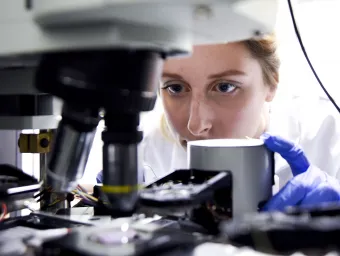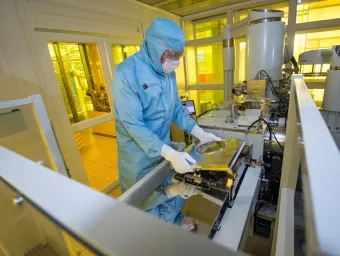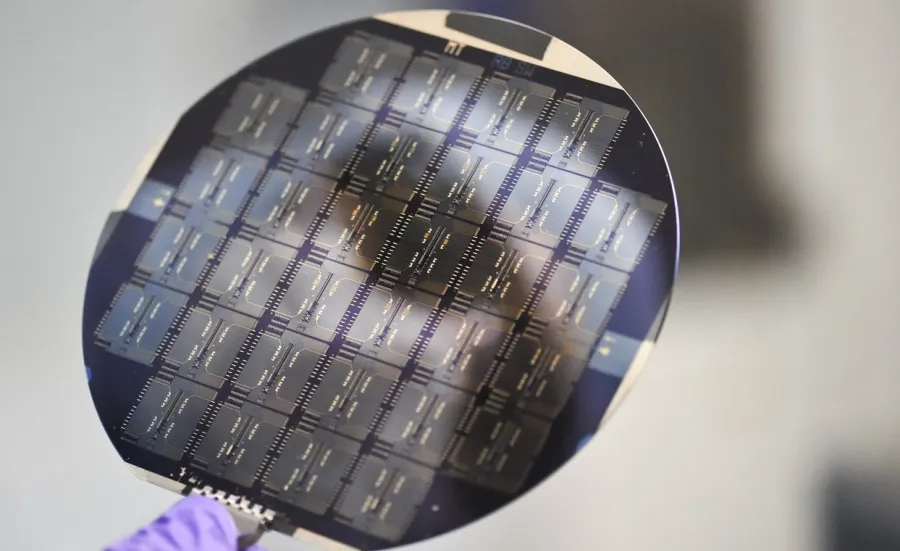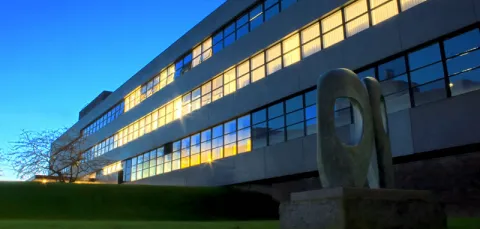18 spin-out companies
Entrepreneurial researchers have generated more than £100m and over 650 jobs
Unique combination of facilities
Including a £120m cleanroom complex and 65 photonics laboratories
A diverse research community
More than 300 staff and students representing over 40 nationalities
Overview
About the Optoelectronics Research Centre (ORC)
Founded in 1989, we are the largest academic photonics research centre in the UK and one of the world’s leading photonics centres.
Formerly known as The Zepler Institute (2018 to 2023), we are home to more than 120 academic and research staff, led by renowned experts in the field of photonics science and technology. We also have more than 100 postgraduate students and more than 55 technical and infrastructure support staff.
We manage more than 50 research laboratories and the unique Zepler Cleanrooms, which are equipped for:
- optical fibre fabrication
- silicon processing
- nanofabrication
- novel materials processing
The ORC has a rich legacy of transforming fundamental research into tangible industry impact. A notable example is Sir David Payne's pivotal role in developing the erbium-doped fibre amplifier, a technology that remains central to global communications.
We have contributed significantly to the growth of photonics applications, including communications technology that underpins the internet, laser technologies, photonic circuits and sensors.
We collaborate with numerous research groups, both within the University and worldwide.
Entrepreneurial colleagues have started spin-out businesses that create impact and contribute to scientific progression and wider economic prosperity.
Research focus and impact
We organise our activities around 4 main research groups, each led by a deputy director:
- Fibres and Communications, led by Professor Periklis Petropoulos
- Nanophotonics Group, led by Professor Nikolay Zheludev
- Photonic Systems, Circuits and Sensors Group, led by Professor Anna Peacock
- Smart Lasers and Special Fibres, led by Professor Michalis Zervas
Each main research group is home to multiple sub-groups and carries out world-leading research backed by flagship research grants. We have a secured research income averaging around £50m. This accounts for more than 30% of UK Research and Innovation's total photonics research funding.
Major projects
Examples of current high-profile research projects include:
- Smart Fibre-Optic High Power Photonics (HiPPo): Developing the next generation of reconfigurable, scalable, resilient, power efficient, disruptive 'smart' fibre laser tools for the upcoming digital manufacturing era
- FASTNET: A Prosperity Partnership with Microsoft to develop hollow core low-latency fibres and cables for ultrafast next-generation optical networks
- MISSION: Releasing the full potential of integrated Mid-Infrared (MIR) photonics
Research quality
The quality of our research was illustrated by our results in the 2021 Research Excellence Framework (REF). The research we submitted made a significant contribution to the General Engineering Unit of Assessment, which was rated 4th in the UK for Grade Point Average (GPA) and Power. 97% of the University’s engineering research has been deemed world-leading, meaning we are influential on a global scale.
Research impact
Our research has had a huge impact on society and people's lives. We also make a major contribution to the UK’s £15.2 billion photonics industry. Many major technological developments, from the internet to revolutionary manufacturing processes, are a direct result of our innovation.
Examples include:
- using sensor technology to mitigate the environmental impact of the oil and gas industry
- using artificial intelligence to develop self-driving lasers, removing the risk of human error and increasing productivity
- new diagnostic and medical technologies, improving lives and creating a multi-million-dollar global market
- pioneering high power fibre lasers, widely used in telecommunications, manufacturing, medicine and science
Facilities
We manage an extensive range of facilities, including the Zepler Cleanrooms complex and 50 laser laboratories.
Zepler Cleanrooms
The 1,600 square metre Zepler Cleanrooms are a state-of-the-art multidisciplinary centre, with facilities for materials and device research in electronics, photonics and nanotechnology.
They offer a unique range of capabilities, for use by both academia and industry, including the world's highest Accelerating Voltage Direct Writing Electron Beam Lithography (EBL) System. This is the first of its kind outside Japan, making the Zepler Cleanrooms the most advanced academic lithography capability in Europe.
Other capabilities include:
- processing up to 200 millimetre wafer scale in our nanofabrication facility and integrated photonics cleanroom
- fabricating hollow core and rare earth doped fibres in our fibre facility
- glass-making and fibre-drawing in our novel and compound glass facility
- growing high-quality silica on planar substrates to form waveguide structures in our flame hydrolysis deposition facility
We also provide access to lab areas suitable for the processing of materials from solution in our hybrid materials and devices facility.
Laser laboratories
These span wavelengths from the ultra-violet (UV) to Mid-Infrared (MIR) and up to power levels into the kilowatt regime.
The laboratories house a wide range of diagnostic equipment for characterisation of optical sources. They also contain a range of state-of-the-art equipment for fabrication and integration of optical fibre components, such as fibre Bragg gratings, to enable laser and optical source development.
Studying with us
We offer an Optical Engineering MSc and a PhD in optoelectronics and photonics.
Our students are part of a diverse and passionate community led by renowned experts in the field of photonics.
For UK and EU PhD students, we offer a number of fully-funded studentships providing an annual stipend of over £20,000 plus £4,200 to visit conferences worldwide.
Our research approach is multidisciplinary. You could be working with lasers, metamaterials, optoelectronics, silicon photonics, fibre optics, hollow core fibres and more advanced materials.
Our research areas include:
- fundamental photonics
- light generation and manipulation
- optical fibres
- optical materials
- integrated photonics
- biophotonics
Our students have gone on to have successful careers in industry, as policy-makers and as leaders in academia.
Equality, diversity and inclusion
The ORC is a place where people from different backgrounds, cultures and perspectives come together to advance the field of photonics.
We believe that equality, diversity and inclusion are essential for fostering a culture of excellence, innovation and collaboration. We are proud to have achieved the Athena SWAN Bronze award, which recognises our efforts to support the career progression of women in science.
We value the diversity of our staff and students, who represent 49 countries and bring knowledge, skills and experience to the ORC. We strive to create an inclusive and supportive community where everyone can thrive and contribute to our shared vision. We respect and accommodate the different needs and preferences of our staff and students, including flexible, hybrid and part-time working arrangements.
We are committed to enhancing the personal and professional development of our staff and students through various initiatives, such as the ORC mentoring scheme, which provides a platform for guidance, feedback and reflection, and our Early Career Researchers Forum, which provides focused training as well as social opportunities.
We also have the ORC Women in Optics group, which aims to empower and inspire women working in the ORC across all job families. The group organises events and training opportunities and liaises with the school management committees.

Our courses
Contribute to the field of photonics and optoelectronics by completing a postgraduate research degree.
Research and industry
Learn more about our research and how we’re working with industry.
-

Our research
Get the full detail of our research through projects, publications and impact stories. Connect with researchers in a particular field.
-

Working with industry
We support industry in the UK and worldwide. Learn about our joint research projects, consultancy, knowledge exchange and services.
Our research community
Explore the many sub-groups that work within our 4 main research groups.
-
Advanced Fibre Applications
-
Advanced Laser Laboratory
-
Advanced Solid-State Sources
-
Computational Nonlinear Optics
-
Distributed Optical Fibre Sensors
-
Fibre Bragg Gratings
-
Fibres and Communications
-
Gas Photonics in Hollow Core Fibres
-
High Power Fibre Lasers
-
Hollow Core Fibre Group
-
Integrated Photonic Devices
-
Laser direct write (LDW) technologies
-
Multimode Photonics
-
Nanophotonics
-
Nonlinear Semiconductor Photonics
-
Optical Engineering and Quantum Photonics Group
-
Optical Fibre Communications
-
Optical Fibre Sensors and Devices
-
Photonic Systems Circuits and Sensors Group
-
Physical Optics
-
Planar Waveguide and Slab Lasers
-
Pulsed Fibre Lasers
-
Pulsed Laser Deposition
-
Silica Fibre Fabrication
-
Silicon Photonics
-
Smart Lasers and Special Fibres
-
Ultrafast Optical Parametric Oscillators
-
Ultrafast X-ray Group
Work with us
-

Jobs at Southampton
Check the University’s job listings to find opportunities within the Optoelectronics Research Centre.


